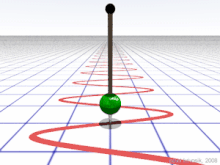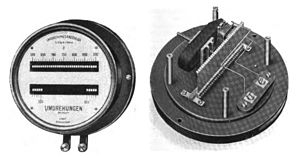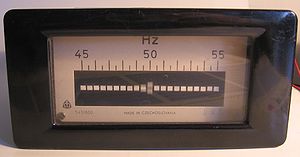Frequency
| Frequency | |
|---|---|
 | |
Common symbols | f,ν |
| SI unit | hertz(Hz) |
Other units |
|
| InSI base units | s−1 |
Derivations from other quantities |
|
| Dimension | |
Frequency(symbolf), most often measured inhertz(symbol: Hz), is the number of occurrences of a repeating event perunit of time.[1]It is also occasionally referred to astemporal frequencyfor clarity and to distinguish it fromspatial frequency.Ordinary frequency is related toangular frequency(symbolω,with SI unit radian per second) by a factor of 2π.Theperiod(symbolT) is the interval of time between events, so the period is thereciprocalof the frequency:T= 1/f.[2]
Frequency is an important parameter used in science and engineering to specify the rate ofoscillatoryandvibratoryphenomena, such as mechanical vibrations,audio signals(sound),radio waves,andlight.
For example, if a heart beats at a frequency of 120 times per minute (2 hertz), the period—the interval between beats—is half a second (60 seconds divided by 120beats).
Definitions and units
[edit]
For cyclical phenomena such asoscillations,waves,or for examples ofsimple harmonic motion,the termfrequencyis defined as the number of cycles or repetitions per unit of time. The conventional symbol for frequency isforν(the Greek letternu) is also used.[3]TheperiodTis the time taken to complete one cycle of an oscillation or rotation. The frequency and the period are related by the equation[4]
The termtemporal frequencyis used to emphasise that the frequency is characterised by the number of occurrences of a repeating event per unit time.
TheSIunit of frequency is thehertz(Hz),[4]named after the German physicistHeinrich Hertzby theInternational Electrotechnical Commissionin 1930. It was adopted by theCGPM(Conférence générale des poids et mesures) in 1960, officially replacing the previous name,cycle per second(cps). The SI unit for the period, as for all measurements of time, is thesecond.[5]A traditional unit of frequency used with rotating mechanical devices, where it is termedrotational frequency,isrevolution per minute,abbreviated r/min or rpm.[6]60 rpm is equivalent to one hertz.[7]
Period versus frequency
[edit]As a matter of convenience, longer and slower waves, such asocean surface waves,are more typically described by wave period rather than frequency.[8]Short and fast waves, likeaudioand radio, are usually described by their frequency. Some commonly used conversions are listed below:
| Frequency | Period |
|---|---|
| 1 mHz (10−3Hz) | 1 ks (103s) |
| 1 Hz (100Hz) | 1 s (100s) |
| 1 kHz (103Hz) | 1 ms (10−3s) |
| 1 MHz (106Hz) | 1 μs (10−6s) |
| 1 GHz (109Hz) | 1 ns (10−9s) |
| 1 THz (1012Hz) | 1 ps (10−12s) |
Related quantities
[edit]
- Rotational frequency,usually denoted by the Greek letterν(nu), is defined as the instantaneous rate of change of thenumber of rotations,N,with respect to time:ν= dN/dt;it is a type of frequency applied torotational motion.
- Angular frequency,usually denoted by the Greek letterω( Omega ), is defined as the rate of change ofangular displacement(during rotation),θ(theta), or the rate of change of thephaseof asinusoidalwaveform (notably in oscillations and waves), or as the rate of change of theargumentto thesine function:
- The unit of angular frequency is theradianper second (rad/s) but, fordiscrete-time signals,can also be expressed as radians persampling interval,which is adimensionless quantity.Angular frequency is frequency multiplied by 2π.
- Spatial frequency,denoted here byξ(xi), is analogous to temporal frequency, but with a spatial measurement replacing time measurement,[note 1]e.g.:
- Spatial periodor wavelength is the spatial analog to temporal period.
In wave propagation
[edit]For periodic waves innondispersive media(that is, media in which the wave speed is independent of frequency), frequency has an inverse relationship to thewavelength,λ(lambda). Even in dispersive media, the frequencyfof asinusoidal waveis equal to thephase velocityvof the wavedividedby the wavelengthλof the wave:
In thespecial caseof electromagnetic waves invacuum,thenv=c,wherecis thespeed of lightin vacuum, and this expression becomes
Whenmonochromatic wavestravel from onemediumto another, their frequency remains the same—only their wavelength andspeedchange.
Measurement
[edit]Measurement of frequency can be done in the following ways:
Counting
[edit]Calculating the frequency of a repeating event is accomplished by counting the number of times that event occurs within a specific time period, then dividing the count by the period. For example, if 71 events occur within 15 seconds the frequency is: If the number of counts is not very large, it is more accurate to measure the time interval for a predetermined number of occurrences, rather than the number of occurrences within a specified time.[citation needed]The latter method introduces arandom errorinto the count of between zero and one count, so onaveragehalf a count. This is calledgating errorand causes an average error in the calculated frequency of,or a fractional error ofwhereis the timing interval andis the measured frequency. This error decreases with frequency, so it is generally a problem at low frequencies where the number of countsNis small.
Stroboscope
[edit]An old method of measuring the frequency of rotating or vibrating objects is to use astroboscope.This is an intense repetitively flashing light (strobe light) whose frequency can be adjusted with a calibrated timing circuit. The strobe light is pointed at the rotating object and the frequency adjusted up and down. When the frequency of the strobe equals the frequency of the rotating or vibrating object, the object completes one cycle of oscillation and returns to its original position between the flashes of light, so when illuminated by the strobe the object appears stationary. Then the frequency can be read from the calibrated readout on the stroboscope. A downside of this method is that an object rotating at an integer multiple of the strobing frequency will also appear stationary.
Frequency counter
[edit]
Higher frequencies are usually measured with afrequency counter.This is anelectronic instrumentwhich measures the frequency of an applied repetitive electronicsignaland displays the result in hertz on adigital display.It usesdigital logicto count the number of cycles during a time interval established by a precisionquartztime base. Cyclic processes that are not electrical, such as the rotation rate of a shaft, mechanical vibrations, orsound waves,can be converted to a repetitive electronic signal bytransducersand the signal applied to a frequency counter. As of 2018, frequency counters can cover the range up to about 100 GHz. This represents the limit of direct counting methods; frequencies above this must be measured by indirect methods.
Heterodyne methods
[edit]Above the range of frequency counters, frequencies of electromagnetic signals are often measured indirectly utilizingheterodyning(frequency conversion). A reference signal of a known frequency near the unknown frequency is mixed with the unknown frequency in a nonlinear mi xing device such as adiode.This creates aheterodyneor "beat" signal at the difference between the two frequencies. If the two signals are close together in frequency the heterodyne is low enough to be measured by a frequency counter. This process only measures the difference between the unknown frequency and the reference frequency. To convert higher frequencies, several stages of heterodyning can be used. Current research is extending this method to infrared and light frequencies (optical heterodyne detection).
Examples
[edit]Light
[edit]
Visible light is anelectromagnetic wave,consisting of oscillatingelectricandmagnetic fieldstraveling through space. The frequency of the wave determines its color: 400 THz (4×1014Hz) is red light, 800 THz (8×1014Hz) is violet light, and between these (in the range 400–800 THz) are all the other colors of thevisible spectrum.An electromagnetic wave with a frequency less than4×1014Hzwill be invisible to the human eye; such waves are calledinfrared(IR) radiation. At even lower frequency, the wave is called amicrowave,and at still lower frequencies it is called aradio wave.Likewise, an electromagnetic wave with a frequency higher than8×1014Hzwill also be invisible to the human eye; such waves are calledultraviolet(UV) radiation. Even higher-frequency waves are calledX-rays,and higher still aregamma rays.
All of these waves, from the lowest-frequency radio waves to the highest-frequency gamma rays, are fundamentally the same, and they are all calledelectromagnetic radiation.They all travel through vacuum at the same speed (the speed of light), giving them wavelengths inversely proportional to their frequencies. wherecis the speed of light (cin vacuum or less in other media),fis the frequency andλis the wavelength.
Indispersive media,such as glass, the speed depends somewhat on frequency, so the wavelength is not quite inversely proportional to frequency.
Sound
[edit]
Sound propagates as mechanical vibration waves of pressure and displacement, in air or other substances.[10]In general, frequency components of a sound determine its "color", itstimbre.When speaking about the frequency (in singular) of a sound, it means the property that most determines itspitch.[11]
The frequencies an ear can hear are limited to aspecific range of frequencies.Theaudible frequencyrange for humans is typically given as being between about 20 Hz and 20,000 Hz (20 kHz), though the high frequency limit usually reduces with age. Otherspecieshave different hearing ranges. For example, some dog breeds can perceive vibrations up to 60,000 Hz.[12]
In many media, such as air, thespeed of soundis approximately independent of frequency, so the wavelength of the sound waves (distance between repetitions) is approximately inversely proportional to frequency.
Line current
[edit]InEurope,Africa,Australia,southernSouth America,most ofAsia,andRussia,the frequency of thealternating currentinhousehold electrical outletsis 50 Hz (close to thetoneG), whereas inNorth Americaand northern South America, the frequency of the alternating current in household electrical outlets is 60 Hz (between the tones B♭and B; that is, aminor thirdabove the European frequency). The frequency of the 'hum' in anaudio recordingcan show in which of these general regions the recording was made.
Aperiodic frequency
[edit]Aperiodic frequencyis therateof incidence or occurrence of non-cyclicphenomena, including random processes such asradioactive decay.It is expressed with the unitreciprocal second(s−1)[13]or, in the case of radioactivity, with the unitbecquerel.[14]
It is defined as arate,f=N/Δt,involving thenumber of entitiescounted or the number ofeventshappened (N) during a giventime duration(Δt);[citation needed]it is aphysical quantityof typetemporal rate.
See also
[edit]- Audio frequency
- Bandwidth (signal processing)
- Chirp
- Cutoff frequency
- Downsampling
- Electronic filter
- Fourier analysis
- Frequency band
- Frequency converter
- Frequency domain
- Frequency distribution
- Frequency extender
- Frequency grid
- Frequency level
- Frequency modulation
- Frequency spectrum
- Interaction frequency
- Least-squares spectral analysis
- Natural frequency
- Negative frequency
- Periodicity (disambiguation)
- Pink noise
- Preselector
- Radar signal characteristics
- Radio frequency
- Signaling (telecommunications)
- Spread spectrum
- Spectral component
- Transverter
- Upsampling
- Orders of magnitude (frequency)
Notes
[edit]- ^The termspatial period,sometimes used in place ofwavelength,analogously corresponds to the (temporal) period.[9]
References
[edit]- ^"Definition of FREQUENCY".Retrieved3 October2016.
- ^"Definition of PERIOD".Retrieved3 October2016.
- ^Serway & Faughn 1989,p. 346.
- ^abSerway & Faughn 1989,p. 354.
- ^"Resolution 12 of the 11th CGPM (1960)".BIPM (International Bureau of Weights and Measures). Archived fromthe originalon 8 April 2020.Retrieved21 January2021.
- ^"Special Publication 811: NIST Guide to the SI, Chapter 8".NIST.28 January 2016.Retrieved2022-11-08.
- ^Davies 1997,p. 275.
- ^Young 1999,p. 7.
- ^Boreman, Glenn D."Spatial Frequency".SPIE.Retrieved22 January2021.
- ^"Definition of SOUND".Retrieved3 October2016.
- ^Pilhofer, Michael (2007).Music Theory for Dummies.For Dummies. p. 97.ISBN978-0-470-16794-6.
- ^ Condon, Tim (2003). Elert, Glenn (ed.)."Frequency range of dog hearing".The Physics Factbook.Retrieved2008-10-22.
- ^Lombardi, Michael A. (2007). "Fundamentals of Time and Frequency". In Bishop, Robert H. (ed.).Mechatronic Systems, Sensors, and Actuators: Fundamentals and Modeling.Austin: CRC Press.ISBN9781420009002.
- ^Newell, David B; Tiesinga, Eite (2019).The international system of units (SI)(PDF)(Report). Gaithersburg, MD: National Institute of Standards and Technology.doi:10.6028/nist.sp.330-2019.sub§2.3.4, Table 4.
Sources
[edit]- Davies, A. (1997).Handbook of Condition Monitoring: Techniques and Methodology.New York: Springer.ISBN978-0-412-61320-3.
- Serway, Raymond A.; Faughn, Jerry S. (1989).College Physics.London: Thomson/Brooks-Cole.ISBN978-05344-0-814-5.
- Young, Ian R. (1999).Wind Generated Ocean Waves.Elsevere Ocean Engineering. Vol. 2. Oxford: Elsevier.ISBN978-0-08-043317-2.
Further reading
[edit]- Giancoli, D.C. (1988).Physics for Scientists and Engineers(2nd ed.). Prentice Hall.ISBN978-0-13-669201-0.

















